There’s a moment, about an hour before sunrise and standing outside, that I feel a hush and an anticipation. It’s as if nature is gathering itself, opening its eyes and getting ready. Owls will hoot, a coyote pack howls a farewell to the stars and then the first bird-calls. Sometimes soft and tentative, sometimes bold and brash, but slowly, slowly different calls start to echo across the landscape. The woods around me turn from black and white to shades of gray, slowly changing into soft colors as the sun nears the dawn horizon.
It’s a transition I never get tired of watching, and I watched it a number of days this spring as I hunted a canny animal – wild turkeys.
TLDR;
- I hunted for eleven days across two sites for spring turkey here in Illinois.
- On my first day, I had encounters with a tom and hen. I continued to have encounters, but no luck in sealing the deal. On my very last day, I harvested my first ever tom turkey.
- I learned valuable lessons from the mistakes I made, and the situations I found myself in
CW
- At the end of this post, there are harvest photos. Nothing gross, but if you don’t like seeing them, don’t look past where I put a PHOTOS BELOW heading.
I started hunting later in life, so much of this is all still new to me. I’d heard the family hunters talk about turkeys and how hard it was, how you had to “learn how to call” and what felt like an insurmountable amount of learning. So I didn’t take it up, until COVID hit and I stumbled across the Illinois Learn to Hunt folks and their YouTube channel. Their content was accessible, informative and I felt like that perhaps this wasn’t too hard to learn? After an aborted attempt to go hunting in 2023, I finally got to hunt last year for 5 days at a nearby state park in northwest Illinois and from the first dawn gobble, I was hooked.
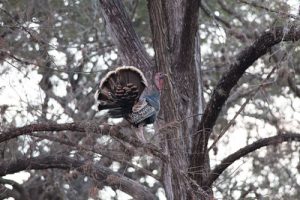
About thirty minutes before the sun rises above the horizons, in the spring breeding season, tom (male) turkeys will start to gobble in their nighttime tree roost. It’s a call to attract hens and to get them to respond so that the tom knows where to go when he leaves the roost to go to ground. Despite Les Nesman’s tragic experimental results, turkeys really do fly – just not gracefully and only for short distances compared to other birds. So the tom wants to know where he should go!
A gobble can carry quite far, depending on the terrain, and especially when the turkey is in the tree. Get two or three toms near each other and it’s a cacophony of noise! It’s invaluable information for a hunter, telling us where the toms are at right now. We can use that to either get close right away, or plan out where we’re going to go, based on the terrain near the tom’s roost.
Turkey hunting in Illinois is very regulated. The spring turkey period is divided up into five “seasons” ranging from five to eight days each. To be allowed to hunt, and depending on where you want to hunt, you may have to enter into a lottery (for public land permit) or apply for a county permit. Both have limited amounts of permits, so you’re not assured of a “tag” to hunt. In 2024, I only had one permit, but I resolved in 2025 to get multiple chances to hunt.
My approach was to first secure a “special hunt area” (SHA) permit for a nearby state park. Then, I would get a county tag which would allow me to hunt private land or (few) public land options that didn’t require a SHA permit. Once I had that county tag, I could then enter a lottery for an “IRAP” site – basically the state of Illinois leases private land and then makes it available to the public on a lottery system.
If it seems confusing to read all this, know that it is confusing and hard to actually manage this! I had entries in my calendar on when to apply, and a checklist so that I knew I was doing things in the right order. But it was worth it, because I was lucky and prepared and I was the happy recipient of two permits to hunt! I would get two seasons out in the field.. and as it ends up, I needed every single day!
My first five days were at a large state park with a combination of rolling fields and lots of thick dense woods covering some steep bluffs, ravines and low creek bottoms.
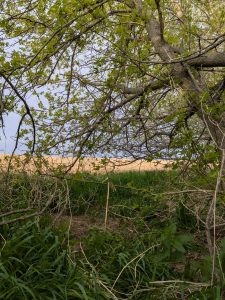
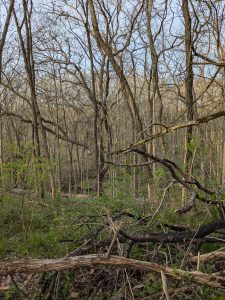
There is a large river dividing the park, and since sound travels, it can be hard to pinpoint where those gobbles come from!
My initial plans were to go back to where I had heard turkeys last year, assuming that they’d probably be there this year. Last year, they’d held up in this spot for several days, so it seemed logical… except it wasn’t reality. They were everywhere else!
So I spent these five days chasing gobbles back and forth across the various areas on either side of the river. I was walking an average of five miles a day! On the very first day, I got within 200 yards or so of a gobbling tom who was responding to my calls! The only problem was he wouldn’t come to me, just kept circling where he was nice and comfy – wanting this hen to come to him! (Which is how turkeys work in nature – the hens seek out the toms.) By the time I managed to get an idea of where he was at, he’d moved on or the noise/movement I made spooked him off.
The next day, I had a hen come within 10 yards of me, close enough that I could see the beautiful iridescence of her plumage. I had no idea how beautiful that could look!
The next to last day at this particular park, the weather changed from mild/calm to gusty moderate winds of about 12-18mph/20-30kph. No turkeys in the woods as all the movement from the wind kept them sticking to areas where they could see. I was feeling pretty low at this point, having not had success, but then I spotted a tom and three hens out in the middle of one of these large fields. As I watched, they moved to the edge and started circling the perimeter. The hunt was on!
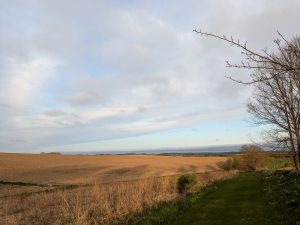
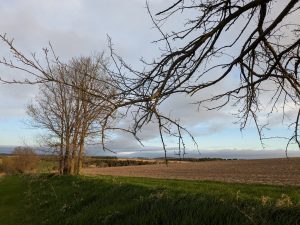
Here’s where I made a rookie mistake. I hopped in my truck and circled around to the backside of this field where I could come up a hill, through some trees on the other side. I had unloaded my shotgun to drive (Illinois laws) and in my rush to get up the hill, I didn’t reload. So you know where this is going…
I come up the hill, probably a little too fast, although I was behind trees. I crested the hill and through the trees and weeds, there was the tom in full strut behind two hens! He was within fifty yards!
I froze, and slowly, every so slowly, backed away. I knew the gun wasn’t loaded, I was nowhere near prepared to set up to work this bird, so I had to circle around where I thought they would go… except they never did. I don’t know if it was that initial encounter, or they heard me in the woods, or just their own preferences, but they did not go where I wanted and I never saw them again. Except…
On my way back to my original area, I passed by a privately owned field and there was a single tom near one of the edges that bordered the public land site. I pulled over and spent thirty minutes trying to get him to come towards me, but like the other birds, he just vanished. I don’t know if I spooked him or he just had different plans.
My last day at this site was another windy day. I hunted a couple of fields but didn’t hear or see anything.
My last six days were at a piece of private land that the state of Illinois leased from the owner. This particular property is divided up into two areas of roughly fifty acres / 20 hectares each. I had hunted the west piece last fall for deer, and that’s where I got my ten-point buck. For turkey, I was on the east side. There is a large ravine in between the two areas with a creek running through it to small ponds at the end. It’s really pretty, but steep!
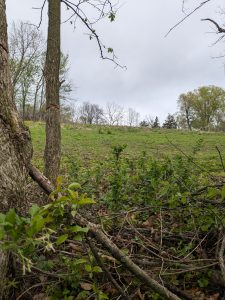
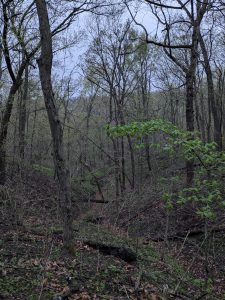
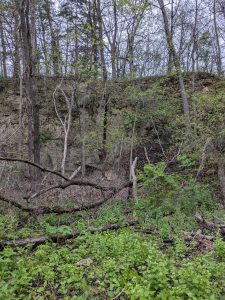
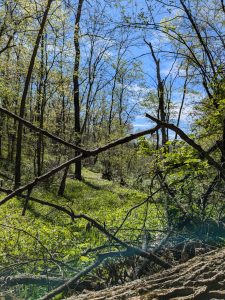
The evening before my first hunt here, I went to scout and see if I could find where toms were going to roost. I saw a tom and hen out in an adjacent piece of property! The only problem, as I soon figured out the next day, is that this road has a car passing about every ten to fifteen minutes or so.
For the first three days, I tried to get that tom and another gobbler on a nearby field to move over to me, but no luck. As it turns out, that tom I had seen was very happy to gobble back at my calls, but he was content with his hen and his comfy spot in the other field. Also, on that third day, I thought I heard faint gobbles at dawn in a different direction, more towards the west hunt area (where I couldn’t go). Around 9am, I heard much closer gobbling, within the western hunt area close to where it bordered my area! I moved towards him, but when I got close to the border and called, he didn’t respond. Either the sounds of my movement spooked him, he may have seen me across the ravine on the other side in some open areas, or he just moved on. Still, that was promising, that turkeys were coming into the property!
This may be foreshadowing…
Since these are small hunt areas, moving around a lot and calling doesn’t really help. It seems, from both my experience and watching other hunters on YouTube, that if a bird doesn’t respond to calling within a couple of hundred yards, it’s time to move on, or sit patiently and wait to see if something comes later. Even moving from the top of this small parcel to the bottom, the most I’m going to do is maybe hear different birds that the terrain is masking – sound does crazy things bouncing and reflecting off of ridge slopes and through draws and ravines.
This also may be foreshadowing…
The fourth day was uneventful, but the fifth day saw a repeat of my center area gobbler visitor! Here again, I made a rookie mistake. Think of this ravine as a steep V. If the turkey is on the left near the top, he’s got a good vantage point of the right/opposite side of the ravine slope. In my rush to find a place to set up, I probably moved too much, going up partway the ravine and trying to find the best place to set.
What I should have done is first gotten a definite good bead on where he was at, either by using binoculars to look in that direction or just stayed still and watched/listened. I also should have stayed low to the creek bottom where I was already at. Either way, he fell silent and didn’t respond to my calls. Still, he’d visited that central area twice now, so clearly he was interested in it.
This is probably the final bit of foreshadowing…
I came up with a new plan of how I was going to approach this on my last day. Come in earlier, stay to the side, but close enough that I could pinpoint him if he came back to that same area. Or, be able to take advantage of terrain if I had to move.
So, at 0445 on my sixth and last day, it’s still dark out, I’m safely at the place I want to be and I settle in for a long sit. I figured I’d hear gobbles far off, and I’d wait to see if he showed up by midday, which seemed to be his routine when he’d visited this area.
The birds and woods were coming alive at 0530 when GOBBLE! comes rolling through the trees, only he’s not on the other side of the property, he’s in my hunt area, towards the center and close!
Having learned my lessons from earlier, I waited to confirm where I was hearing him and how close. After a couple more gobbles, I had a good idea.
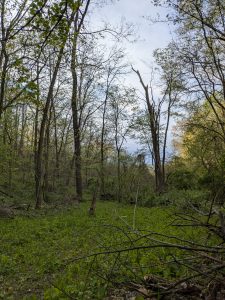 Toms like small areas where they can strut and call, but it’s not so wide open that they don’t have access to safety. Toms also like to roost on ridge sides, near ridge tops. They can easily fly down to the ridge top and move on to where they want to go. They can see better on the side as well.
Toms like small areas where they can strut and call, but it’s not so wide open that they don’t have access to safety. Toms also like to roost on ridge sides, near ridge tops. They can easily fly down to the ridge top and move on to where they want to go. They can see better on the side as well.
Having been walking this property quite a bit, I knew there was an area I had nicknamed “the pretty ridge.” It had a dead-end trail that led to a nice overlook of the woods and ravine below it. My gobbling tom was right there somewhere on that ridge point.
I moved my way around as quickly, yet as quietly as I could. I made sure the gun was loaded *and* the red-dot was on. Learning from my mistakes…
He kept gobbling as I crept down this path along the pretty ridge to where it curved towards where the tom was at. Based on his gobbles, I was guessing I was easily within 100 yards (~ 100 meters) of him, close enough to try to lure him in! I found a tree that I could sit in front of, with cover between me and the path. I set the gun next to me (FORESHADOWING) and got a camo cover out over my legs. I also made a soft yelping call with a mouth call – to me it sounded terrible, but I was out of breath and the adrenaline was pumping like crazy!
As I’m adjusting the cover and settling in, I catch movement out on the path – within 30 seconds of my yelp, he was already coming in to see where this hen was! And my gun was on the ground next to me! Did I mention that turkeys’ main defense against predators is their insanely superior vision?
As slow and low as I could, I picked up my gun, got into firing position. The turkey was clearly on a mission, his head outstretched high as he looked for this hen. I don’t know if he saw me or not, but he moved so that I had a clear shot…
I had dry-fire practiced with my shotgun in my garage, with a picture set up on a wall ten feet away, but scaled for what a turkey would look like at 25 yards. So I knew how things would feel. Even still, this happened so fast that when the BANG of the shot rang out, it made me jump a bit. But my aim was true! My day was over within the first 30 minutes of it being legal to hunt.
After two years, five days plus eleven days of putting in the work, learning lessons and not giving up, I had finally harvested my first wild turkey. It was a pretty indescribable moment of gratitude, adrenaline release and pride. The family hunters had been right, turkey hunting *is* hard, but it’s an incredible experience.
My harvest tom had a 9″ beard and an even fan, indicating he was an adult. However, he had no spurs! That’s a genetic mutation and while rare, not unheard of. So my first turkey was atypical. I think that’s pretty neat!
Was this my center-area visitor from the previous two days? I can’t be sure. Maybe he’d heard the calls and thought he’d get close to where he’d heard my yelps, thinking a hen lived around here? Maybe this was just another tom from elsewhere? Given what I had heard from turkeys the previous days, it’s a pretty good chance this was my visitor.
There are tons of things I learned throughout this hunt, just like deer hunting. It’s hard to put them all to words because it’s making connections of things – use terrain THIS way, don’t go THAT way, remember THIS thing… and so on. I am keeping a diary though, of all my trips – including location, weather, what happened and lessons learned. That way, I can go back and reread and refresh and hopefully not have to relearn lessons again.
If you’ve made it this far, I hope you found this interesting! If you hunt turkeys, how did your season go this year?
HARVEST PICTURES BELOW
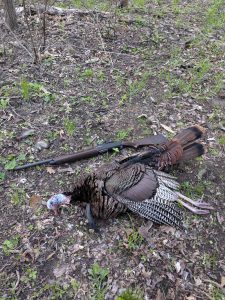
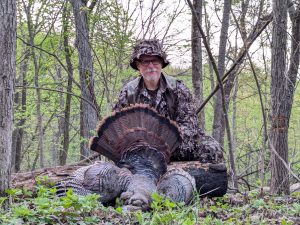
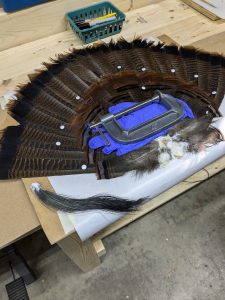
Shotgun is a Winchester SX-4, with a turkey barrel, full choke and Hawke Reflex red dot. I was using Winchester Super X #5 shot.
I’m already drying out the fan and beard for a mount. The C-clamp is on it to help press the fan down while it’s drying.